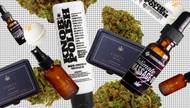What’s the difference between STI and STD? STI stands for sexually transmitted infection, and STD stands for sexually transmitted disease. “I feel like we’re trying to de-stigmatize and get away from the disease language,” says Christina Madison, associate professor of pharmacy practice at Henderson’s Roseman University of Health Sciences. “It’s an infection, you’re not diseased.”
Love & Sex
- A first visit to new Downtown wedding chapel Sure Thing
- Some of our readers’ best, Instagram-shared Vegas marriage proposal stories
- Tips for spicing up a long-term relationship
- Vegas-based porn star Charlotte Sartre talks diversity, Dostoyevsky, puppets and more
- Exploring the dating lives of local porn performers
- How to protect yourself from dangerous STDs
- Down and doobie: Counting the ways cannabis can complement sex
Are STIs on the rise in Las Vegas? “The quick answer to that is STIs are on the rise across the country, and our Valley isn’t unique in that regard. [Las Vegas is] still kind of in the middle range—we’re not the highest and we’re not the lowest,” Madison says. “Last year the CDC reported the highest number of reported [STI] cases [in the U.S.] since we’ve been keeping numbers.”
Gonorrhea, chlamydia and syphilis are all on the rise. The cause? “Part of what we’re seeing is a lack of education, both for those getting the infections and [healthcare] providers,” Madison says. General practitioners typically don’t ask about a patient’s sexual history. “That should be a part of all primary care visits, in order to determine the risk for HIV [and STI] acquisition.”
Madison also says the rise of the casual dating app has allowed STIs to spread. “People [are] having encounters with individuals that they’re less likely to know more intimately than they have in the past and therefore less likely to disclose if they’ve had an STI.”
The Huntridge Family Clinic and Southern Nevada Health District offer three-site STI testing. It involves a (painless) urine sample, along with throat and rectal swabs. “We’re seeing [gonorrhea] in other areas of the body, which is why we recommend the three-site testing,” says Madison, who also works for Huntridge Clinic.
You don’t have to have symptoms to get tested. “Anybody starting a new relationship or with a new partner should make sure that they get themselves tested,” Madison suggests. “Sex should be an enjoyable, positive experience. The way to do that is to ask those questions.”




